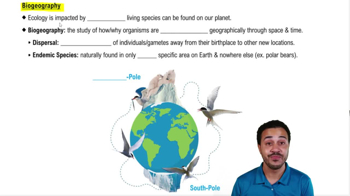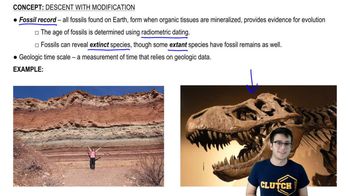Fossilized stromatolites a. formed around deep-sea vents. b. resemble structures formed by bacterial communities that are found today in some shallow marine bays. c. provide evidence that plants moved onto land in the company of fungi around 500 million years ago. d. contain the first undisputed fossils of eukaryotes.
Which factor most likely caused animals and plants in India to differ greatly from species in nearby southeast Asia? a. The species became separated by convergent evolution. b. The climates of the two regions are similar. c. India is in the process of separating from the rest of Asia. d. India was a separate continent until 45 million years ago.
 Verified step by step guidance
Verified step by step guidance
Verified video answer for a similar problem:
Key Concepts
Plate Tectonics

Biogeography

Convergent Evolution

The oxygen revolution changed Earth's environment dramatically. Which of the following took advantage of the presence of free oxygen in the oceans and atmosphere? a. the evolution of cellular respiration, which used oxygen to help harvest energy from organic molecules b. the persistence of some animal groups in anaerobic habitats c. the evolution of photosynthetic pigments that protected early algae from the corrosive effects of oxygen d. the evolution of chloroplasts after early protists incorporated photosynthetic cyanobacteria
Large-scale, worldwide adaptive radiations have occurred in which of the following situations?
a. when there are no available ecological niches
b. after each of the big five mass extinctions
c. after colonization of an isolated island that contains suitable habitat and few competitor species
d. whenever an evolutionary innovation was needed for organisms to thrive
